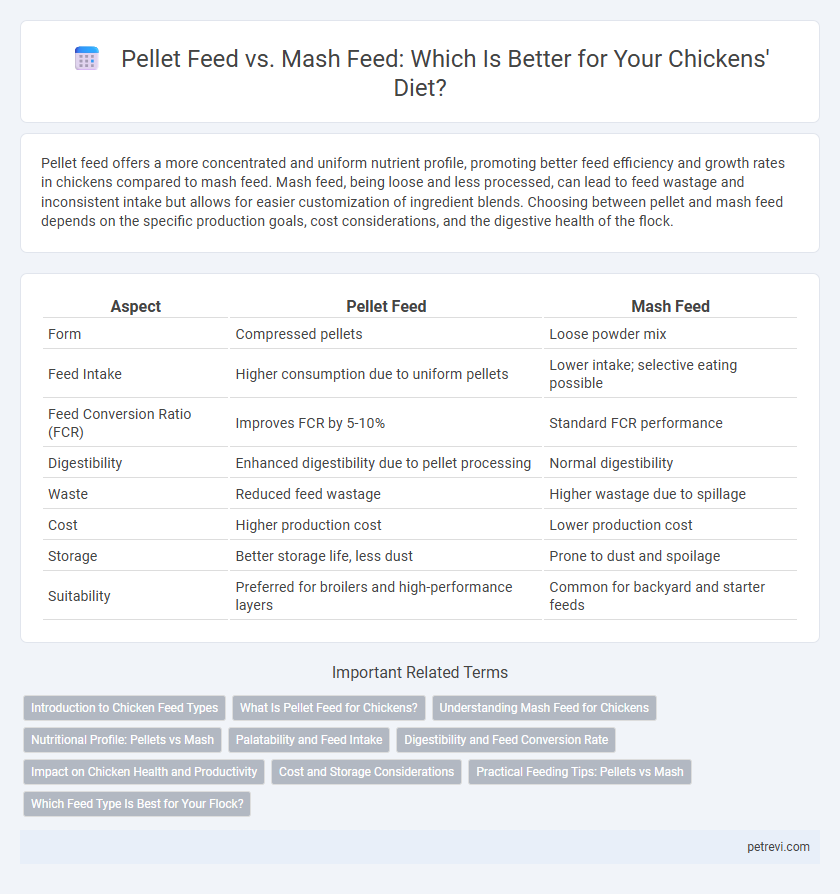Pellet feed offers a more concentrated and uniform nutrient profile, promoting better feed efficiency and growth rates in chickens compared to mash feed. Mash feed, being loose and less processed, can lead to feed wastage and inconsistent intake but allows for easier customization of ingredient blends. Choosing between pellet and mash feed depends on the specific production goals, cost considerations, and the digestive health of the flock.
Table of Comparison
| Aspect | Pellet Feed | Mash Feed |
|---|---|---|
| Form | Compressed pellets | Loose powder mix |
| Feed Intake | Higher consumption due to uniform pellets | Lower intake; selective eating possible |
| Feed Conversion Ratio (FCR) | Improves FCR by 5-10% | Standard FCR performance |
| Digestibility | Enhanced digestibility due to pellet processing | Normal digestibility |
| Waste | Reduced feed wastage | Higher wastage due to spillage |
| Cost | Higher production cost | Lower production cost |
| Storage | Better storage life, less dust | Prone to dust and spoilage |
| Suitability | Preferred for broilers and high-performance layers | Common for backyard and starter feeds |
Introduction to Chicken Feed Types
Pellet feed for chickens combines ground ingredients compressed into uniform shapes that improve feed intake and reduce waste. Mash feed consists of a loose mixture of ground grains and supplements, offering flexibility in nutrient composition and ease of digestion. Choosing between pellet and mash feed depends on factors like chicken age, feeding behavior, and production goals to optimize growth and health.
What Is Pellet Feed for Chickens?
Pellet feed for chickens consists of compressed raw ingredients formed into small, dense pellets that ensure uniform nutrient distribution and minimize feed wastage. Pellet feed improves feed conversion efficiency by reducing selective feeding among chickens compared to mash feed, which is loose and powdery. The manufacturing process of pellet feed involves grinding, conditioning, and pelletizing, resulting in a consistent texture that supports better growth and productivity in poultry.
Understanding Mash Feed for Chickens
Mash feed for chickens consists of finely ground grains and ingredients mixed into a uniform blend, improving nutrient consistency and digestibility. This form allows chickens to consume a balanced diet in every bite, supporting optimal growth and egg production. Unlike pellet feed, mash feed promotes natural feeding behaviors and can reduce the risk of selective feeding, enhancing overall flock health.
Nutritional Profile: Pellets vs Mash
Pellet feed for chickens offers a more uniform and consistent nutritional profile compared to mash feed, ensuring balanced intake of protein, vitamins, and minerals in every bite. Pellets reduce feed wastage and improve nutrient absorption due to their compressed form, which enhances digestibility. Mash feed, while allowing customization in ingredient mixing, may lead to inconsistent nutrient consumption and higher feed separation, impacting overall dietary efficiency.
Palatability and Feed Intake
Pellet feed improves palatability for chickens by providing a uniform texture and preventing ingredient separation, leading to increased feed intake and better growth performance. Mash feed, while more economical, often results in selective feeding due to ingredient sorting, reducing overall nutrient consumption and feed efficiency. Studies show chickens consuming pellet feed exhibit higher daily intake and improved body weight gain compared to those fed mash diets.
Digestibility and Feed Conversion Rate
Pellet feed offers improved digestibility and higher feed conversion rates compared to mash feed due to its uniform shape and density, promoting consistent intake and nutrient absorption in chickens. Studies indicate that chickens consuming pellet feed exhibit better growth performance and lower feed wastage, enhancing overall production efficiency. The pelleting process also reduces feed sorting and enhances enzyme activity, further optimizing nutrient utilization in poultry diets.
Impact on Chicken Health and Productivity
Pellet feed enhances chicken health and productivity by improving nutrient absorption and reducing feed wastage compared to mash feed. The compact form of pellets promotes consistent intake and supports better growth rates, leading to higher egg production and meat quality. Mash feed can cause selective feeding and uneven nutrient consumption, negatively affecting overall flock performance.
Cost and Storage Considerations
Pellet feed offers cost-efficiency through uniform nutrient distribution, reducing waste and promoting faster weight gain, which can lower overall feed expenses for chicken farmers. Mash feed, while often cheaper to produce, requires more storage space and careful handling to prevent spoilage and nutrient degradation, increasing logistical challenges. Choosing between pellet and mash feed depends on balancing upfront costs with storage capabilities and desired feed conversion ratios.
Practical Feeding Tips: Pellets vs Mash
Pellet feed offers superior nutrient density and reduces feed wastage compared to mash feed, making it ideal for efficient chicken growth. Mash feed allows for easier ingredient customization and is often preferred in small-scale or backyard poultry farming due to its cost-effectiveness. Practical feeding tips include gradually transitioning chickens from mash to pellets to avoid digestive issues and ensuring consistent particle size in mash to promote uniform intake.
Which Feed Type Is Best for Your Flock?
Pellet feed offers uniform nutrient distribution and reduces waste, promoting faster weight gain and improved feed conversion in chickens. Mash feed provides more flexibility in ingredient composition but may lead to selective eating and inconsistent nutrient intake. Choosing the best feed depends on flock size, production goals, and management style, with pellets favored for intensive systems and mash preferred for small-scale or specialized diets.
Pellet feed vs Mash feed for Chicken Diet Infographic

 petrevi.com
petrevi.com